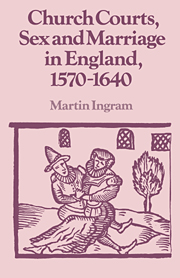Book contents
- Frontmatter
- Contents
- List of tables
- List of maps
- Preface
- Conventions and abbreviations
- Introduction
- PART 1 THE LEGAL AND SOCIAL BACKGROUND
- PART 2 SEX AND MARRIAGE: THE PATTERN OF PROSECUTIONS
- 5 Matrimonial causes: (i) the breakdown of marriage
- 6 Matrimonial causes: (ii) marriage formation
- 7 Prenuptial fornication and bridal pregnancy
- 8 Incest, adultery and fornication
- 9 Aiding and abetting sexual offences
- 10 Sexual slander
- PART 3 CHURCH COURTS AND SOCIETY
- Bibliography
- Index
- Past and Present Publications
7 - Prenuptial fornication and bridal pregnancy
Published online by Cambridge University Press: 24 September 2009
- Frontmatter
- Contents
- List of tables
- List of maps
- Preface
- Conventions and abbreviations
- Introduction
- PART 1 THE LEGAL AND SOCIAL BACKGROUND
- PART 2 SEX AND MARRIAGE: THE PATTERN OF PROSECUTIONS
- 5 Matrimonial causes: (i) the breakdown of marriage
- 6 Matrimonial causes: (ii) marriage formation
- 7 Prenuptial fornication and bridal pregnancy
- 8 Incest, adultery and fornication
- 9 Aiding and abetting sexual offences
- 10 Sexual slander
- PART 3 CHURCH COURTS AND SOCIETY
- Bibliography
- Index
- Past and Present Publications
Summary
In handling marriage contract cases, it has been shown, the church courts laid increasing stress on solemnisation in church as the only guarantee of a socially and legally acceptable marriage. An important complementary development in the period c. 1570–1640 was that the courts, by stepping up disciplinary prosecutions for prenuptial fornication and bridal pregnancy, tried more firmly to insist that betrothed couples should remain chaste before they were married in church: that a properly solemnised marriage alone made sexual relations licit. This policy ran counter to popular customs and attitudes, which were fairly tolerant of sexual contact between couples who were courting seriously, and it is not surprising that the ecclesiastical authorities were never wholly successful in ensuring that the offence was regularly and consistently presented, far less in suppressing bridal pregnancy itself. But the courts' increasing rigour was actively supported by some parochial interests, especially in areas under economic pressure, and many churchwardens did cooperate in prosecuting guilty couples. The church courts' work in this field probably reinforced the pre-existing trend towards the decline of marriage contracts, re-emphasised the importance of a church wedding as the only acceptable mode of entry into the privileges and responsibilities of marriage, and may even have helped to produce the decline in bridal pregnancy rates visible in some parishes in the early seventeenth century.
The demographic facts about bridal pregnancy were outlined earlier. In early modern England generally, at least a fifth of all brides were with child by the time they got married in church; but rates varied between communities and in some places declined from the late sixteenth to the early seventeenth century.
- Type
- Chapter
- Information
- Church Courts, Sex and Marriage in England, 1570–1640 , pp. 219 - 237Publisher: Cambridge University PressPrint publication year: 1988



